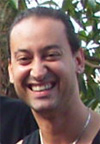|

ctors like all artists strive to release their creativity. To do this they must be creatively released. When an actor is creatively released he or she is: unhindered, spontaneous, trusting, responsive,
impulsive and emotionally committed. When this occurs, the audience believes the performance and is engaged. Believable acting comes from authentic behaviour; the actor trusting their impulses and in
response to what is actually going on at the time.
For most of us the enemy of believable acting is fear, a natural fear, experienced whenever we are called upon to speak or perform in
public. For the experienced actor this fear can be challenging, for the beginning actor it can be paralysing.
Scientific research suggests that within each of us is a natural drive to belong to the group, that humans are social animals; we are hard
wired to get along as if our very survival depends on it. The consequence of this genetic disposition is the fear we experience whenever we are called upon to speak or perform in public. Actors'
Equity in the United States of America did an experiment in which actors' vital signs were monitored during performance and their stress levels compared to those of other professions. The only group found
to have the stress levels of performing actors was U.S. Navy test pilots.
Building a process of channeling and using the natural fear is paramount. When working with actors in our training, we do this by
paying a great deal of attention to the practice of naming and exposing fear. Fear comes in all shapes and sizes and while it is true to say we need fear to motivate us in situations of peril it is also true
to say that harnessing and channeling fear can lead us to some of the greatest moments of our life. Great performances in theatre and sport for example, often occur when the stakes are high.
But in order to channel the fear we must know it and name it. Unchanneled fears are blocks. Blocks to creativity; limitations
habitually self imposed and self sustained. Naming and exposing is a way of dissolving the blocks to creativity. It sounds simple because it
is simple. What's difficult is overcoming the sound of the inner voice who is adamant that the best protection is silence – keeping it to ourselves. Fear says: 'do not say my name', because it knows as
soon as the words are uttered out loud the fear itself begins to lose its power. Naming and exposing fears puts them into perspective, often
the over-riding feeling is relief. It takes courage to expose. And should be done in a none judgmental environment with a supportive and understanding ensemble or class.
A student of acting, Ramiro, gives a wonderful account of this process in his journal.
I was on a real downer today. Slowly I got myself out of it. We begun class having one of our talks. I look forwards to these, as they are a
good way to pin point where everyone is on the map. One by one people talked about how they felt, where they are at, etc. When it came to my turn I found it hard to talk. Martin asked a few relevant
questions to do with my mood. 'You have an audition with James Cameron in an hour. Can you get yourself out of that mood?' The answer is, for an audition with Mr. Cameron I can get myself into any mood.
I liked the question and of course it had the effect of getting me out of my shitty mood… Fear was widely discussed. Where does our fear  come from? What is its nature? Difficult questions. One thing is for sure. This is an enemy in the dark. come from? What is its nature? Difficult questions. One thing is for sure. This is an enemy in the dark.
It does not want to be recognized. It wants to be faceless and laugh at you from the crowd.It is hoping for the acquiescence of the victim. The fact
that most of us don't want to reveal the thing that hurts us, paralyses us. Fear thrives in our silence. There is only one way to defeat this thief of
confidence. Name and expose him. Today I truly understood the nature of this weapon. It takes the power away from fear, and like Martin mentioned, back into ourselves. A lesson well-learnt.
Taking inspiration from Ramiro's words we are reminded that fear thrives in silence and to acknowledge this re-instates our power,
releasing creativity. The practice of naming and exposing fears as a means of channeling energy can be done on our own, or in an ensemble environment. It is a simple yet powerful tool.
As an artist I desire to be secure in my practice and generous of spirit. When I recognise and channel my own fears I am brought closer to
understanding and empathising with others. As I move closer to an honest interaction with myself I move closer to an honest and openinteraction with others.
Ultimately it is only fear that will divide us and integration through openness, love and empathy that will bring us together: as individuals
, as an ensemble, as humanity.
|